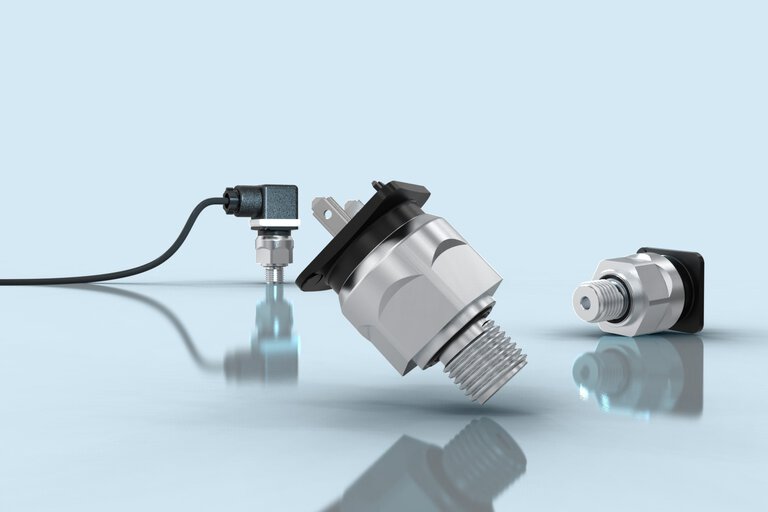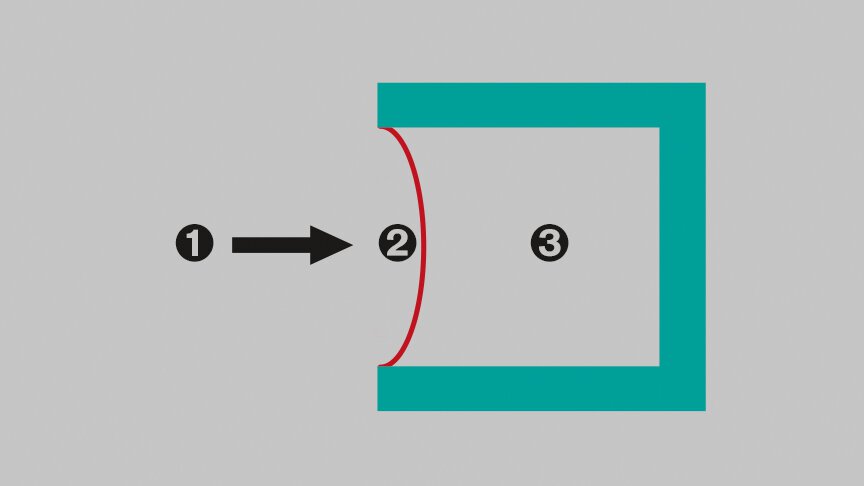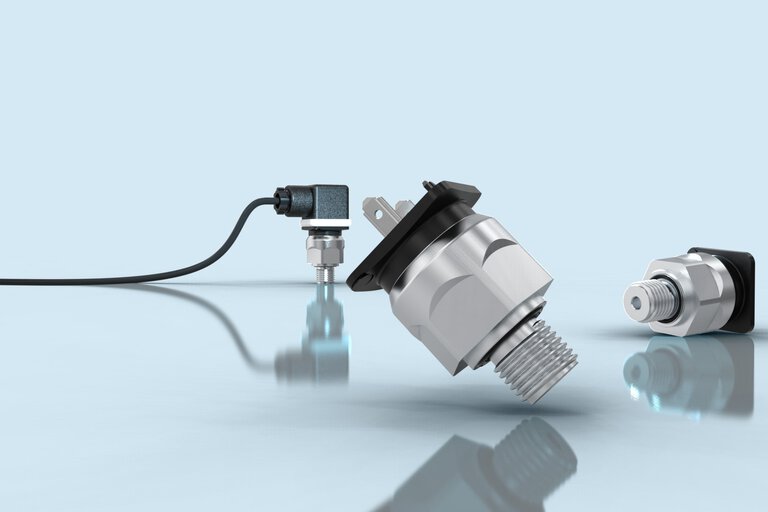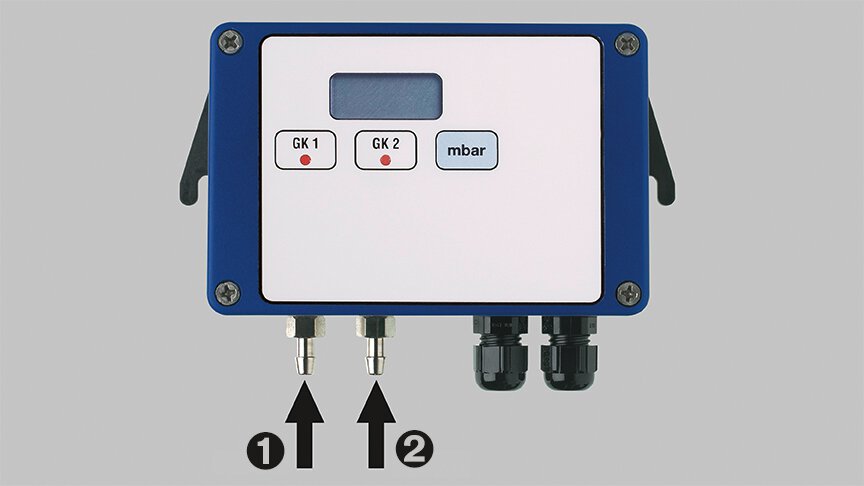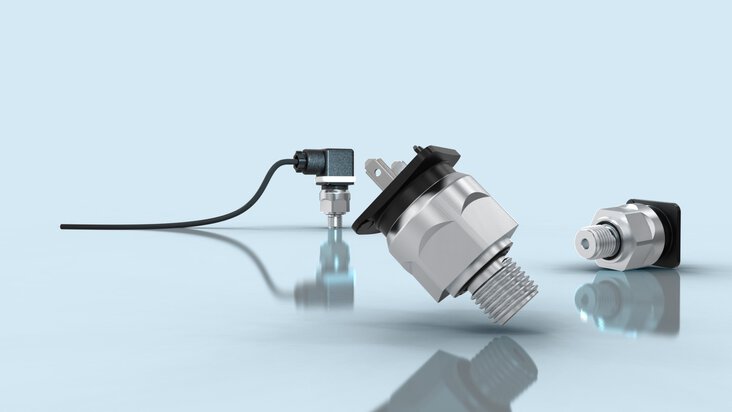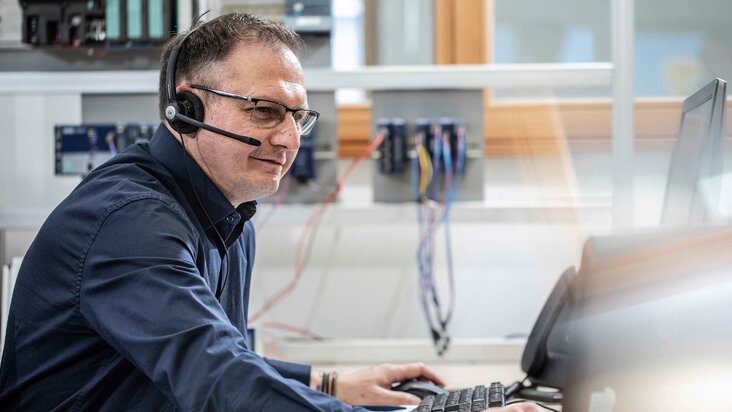
Pressure sensors / Pressure sensor – The most important facts in brief
Pressure sensors play a crucial role in numerous industrial applications. After all, they detect precise pressure changes and output the pressure as an electrical signal. In our FAQ section, we give you a comprehensive overview of how they work, their design and the measuring systems used.
Table of contents
What is a pressure sensor?
Pressure sensors, often referred to as pressure transmitters or pressure transducers, measure relative, absolute or differential pressure in various applications. These include, for example, process technology, mobile applications or compressor construction. In some cases, they are available as a combined pressure and temperature sensor so that both parameters can be measured with one device.
How do pressure sensors work?
Pressure sensors usually have a membrane that is subjected to different pressures on both sides.
In an absolute pressure sensor there is an airless chamber (vacuum) on one side. On the other side is the process pressure, which deforms the mebrane when it changes. This degree of deformation is measured and is a measure of the difference between process pressure and vacuum (absolute pressure).
With a relative pressure sensor, the chamber is open so that atmospheric pressure is present. The mebrane deforms depending on the difference between process pressure and atmospheric pressure (relative pressure).
Differential pressure sensors have 2 process connections; the pressures act in opposite directions on the membrane. The measurement result is the difference between the two pressures (differential pressure).
How is a pressure sensor constructed?
A pressure transmitter has a process connection via which it is placed in the process. It is usually screwed into the process, but sometimes the connection is also made via a flange.
The sensor technology, which converts the pressure into an electrical signal, is located in a housing. This is also where the evaluation electronics are located, which generate an analog or digital signal from the raw signal. The electrical connection is usually realized via a plug contact.
As a rule, pressure sensors output the measured pressure as an analog signal (usually via a 4 to 20 mA current signal). However, they often also have interfaces such as IO-Link, canOPEN or HART. Pressure transmitters with Single Pair Ethernet are often also directly accessible via cloud applications.
Sensors with display and other functionalities are also frequently required in process technology.
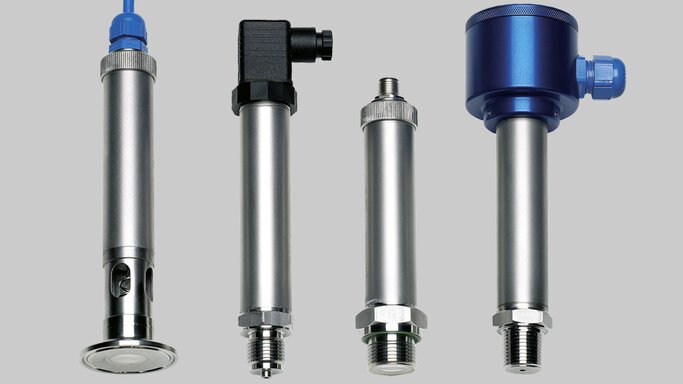
Examples of pressure sensors
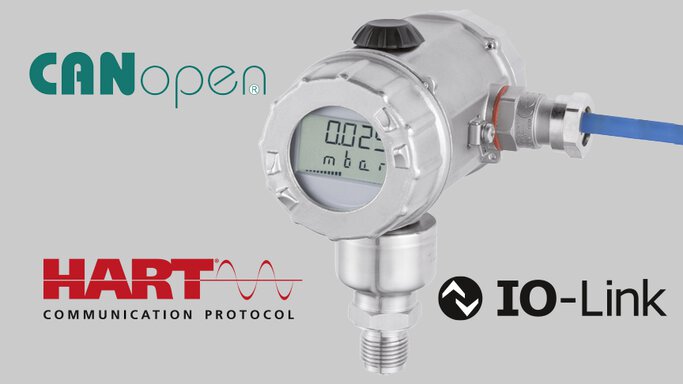
Pressure transmitter with display for process technology
When must pressure sensors have a flush membrane?
Pressure transmitters have a membrane whose deformation or deflection is a measure of the process pressure. In most cases, the membrane is protected inside the sensor. If there are pressure peaks in the system that could damage the measuring system, the pressure channel is fitted with a throttle (flow resistance) so that the brief pressure peaks do not reach the membrane.
When measuring in viscous media, the pressure channel would become blocked. For this reason, a flush membrane must be used.
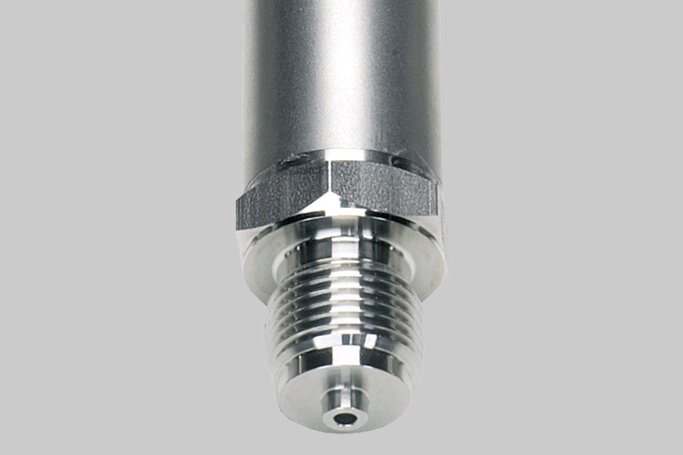
Pressure transmitter with internal membrane

Pressure transmitter with flush membrane
Which pressure sensor is the right one?
The selection of a suitable pressure sensor depends on various factors, including the specific requirements of the application. For example, the pressure range, accuracy and environmental conditions play an important role. Find out more in the following video.
Which measuring systems are used in a pressure sensor?
The choice of measuring system depends mainly on the level of pressure to be measured. The most important types of pressure sensors are listed below.
Inductive pressure sensors (0.0001 to 1 bar)
Inductive pressure sensors allow the measurement of extremely low pressure values in clean air. The air to be measured is fed to the sensor via hoses, so that the sensors have a different design than shown above.
The sensor always measures a pressure difference via the two hose connections. For example, if a hose line comes from a cleanroom and the second connection is left open, such a pressure sensor measures the overpressure in the cleanroom. This is very important, because then clean air escapes from the cleanroom through small leaks and no contaminated air enters the cleanroom.
If both connections have the pressure that is present before and after an air filter, the differential pressure is measured. In this application, it is a measure of the degree of contamination of the filter.
The measuring system consists of two screwed metal halves, to each of which a coil is attached in the middle. A membrane with an iron plate is located between the halves. If the pressure in a chamber increases, the differential pressure changes and with it the distance between the iron plate and the coils. The distance influences the inductance of the coils and is therefore a measure of the pressure difference.
Special features of inductive pressure sensors
- Measurement of extremely small pressure difference possible
- Low overpressure resistance
- The measuring medium must be clean air.
- Pressure comparison of systems that are located at different locations
- Relatively low medium temperature range (e.g. -10 to +50 °C)
Capacitive pressure sensors (0.05 to 25 bar)
Capacitive pressure transmitters require a higher minimum pressure. However, pressure measurement in gases and liquids is also possible with these sensors from a pressure of 0.05 bar.
The pressure sensor consists of a ceramic base body whose structure with metallic (gold) coated surfaces represents a capacitor.
The upper capacitor plate is the fixed side (Cp electrode), the moving membrane represents the second plate (counter electrode). The solder ring connects the membrane to the base body and maintains the distance. If pressure is applied to the membrane, the distance between the plates changes and with it the capacitance.
The overload safety of this sensor is very high (100 x Prated), as the moving membrane can only move as far as the fixed plate and is pressed against it. Depending on the design, the sensors can be used to measure relative or absolute pressure.
The chemical resistance of the ceramic is very good and is hardly subject to corrosive ageing processes, which results in high long-term stability. However, a seal is used to seal the housing. Depending on the process medium, a suitable sealing material must be selected with regard to material resistance.
Special features of capacitive pressure sensors
- Measurement of even very low pressure values in gases and liquids
- Absolute pressure measurement possible
- Extremely overload-resistant
- Sealing material required between sensor and pressure connection
Piezoresistive pressure sensors (0.04 to 100 bar)
This type of pressure sensor can be used in an extremely wide pressure range. Depending on the pressure, a piezoresistive silicon chip changes its resistance value.
The chip is not placed on the membrane, but is directly exposed to the process pressure. For measuring very low pressure values - exclusively in gases - the process medium is fed directly to the chip (approx. 0.04 to 0.1 bar). If a higher pressure is measured, filling oil is used in the sensors.
The process pressure is transferred to the filling oil via a membrane and this is fed to the silicon chip. This type of design enables cost-efficient pressure measurement in gases and liquids up to 100 bar. In principle, sensors for measuring up to 1000 bar can also be constructed. However, due to the relatively high costs, the method is only used at such high pressures if there are special reasons for doing so.
The semiconductor material is very temperature-sensitive and so the temperature compensation and thus the evaluation electronics for these sensors are relatively complex - this is a challenge for the manufacturer. High-temperature versions can also be realized due to the pressure transmission through the filling oil.
Special features of piezoresistive pressure sensors
- Require a minimum pressure of only approx. 0.04 bar (for gases) and 0.1 bar (for liquids)
- Measurement of absolute pressure possible
- High overload safety
- High burst pressure
- No seal necessary
Ceramic pressure sensors in thick film (1.6 to 1000 bar)
The base body of this pressure sensor with the membrane is made of ceramic. The thickness of the membrane varies depending on the pressure range. Strain gauges are applied to the side of the membrane facing away from the pressure using a screen printing process and then burnt in. A seal is required between the sensor and the pressure connection to seal the ceramic sensor in the measuring system. The base body is located completely inside the sensor and is not visible from the outside. The process pressure is applied to the membrane via the pressure channel. The overload range of the brittle ceramic is quite high, but the burst pressure is lower than with metal carrier materials.
Special features of ceramic pressure sensors
- Require a minimum pressure of approx. 1.6 bar, otherwise the measurement can be carried out up to an extremely high pressure
- No absolute pressure measurement possible
- Cost-effective manufacturing process
- Seal required
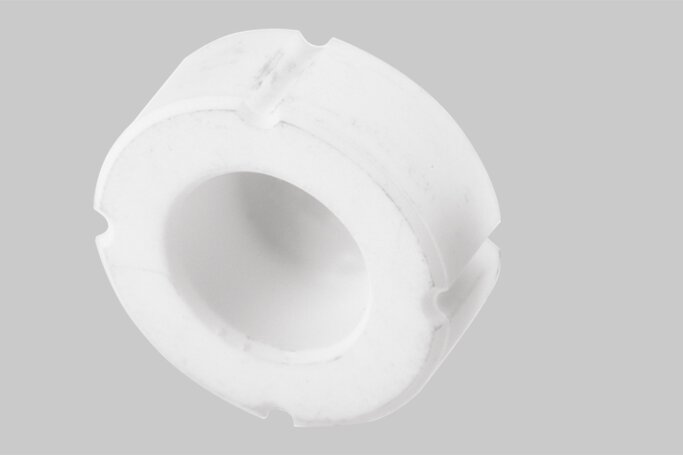
Ceramic base body of a thick-film pressure sensor
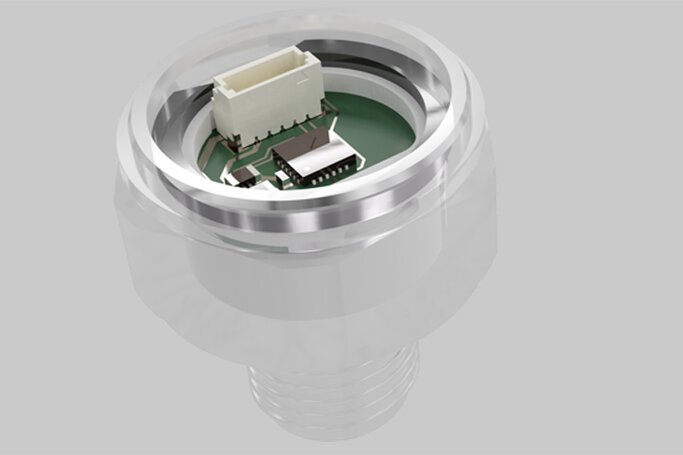
Ceramic thick-film pressure sensor
Thin-film metal pressure sensors (40 to 1000 bar)
These pressure transmitters can also measure up to 1000 bar, although they can only be used from 40 bar. The base body of the metal thin-film pressure sensors and the membrane are usually made of stainless steel. Strain gauges with a layer thickness of <1µm are applied using a chemical process, which is why they are referred to as thin-film sensors. This type of pressure sensor is very robust against vibrations and shock loads. It can be welded to the housing so that no additional seal is required.
Special features of thin-film pressure sensors
- Require a minimum pressure of about 40 bar, otherwise the measurement can be made up to an extremely high pressure.
- Compared to thick-film sensors, thin-film sensors only have a slightly higher overload resistance, but a significantly higher burst pressure.
- No absolute pressure measurement possible
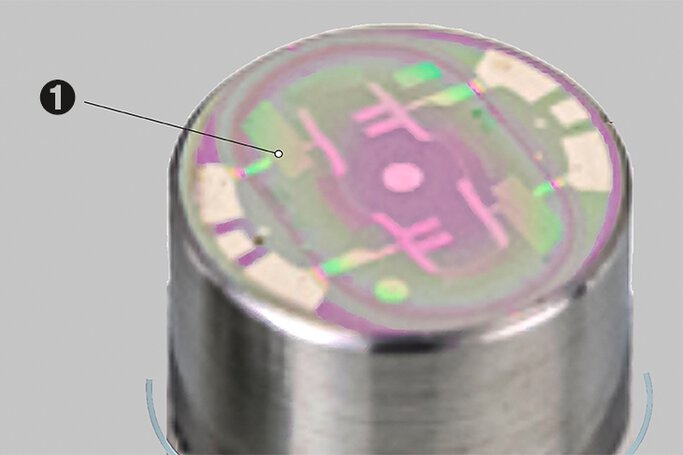
Thin-film pressure sensor – (1) Etched structure on the side facing away from the pressure
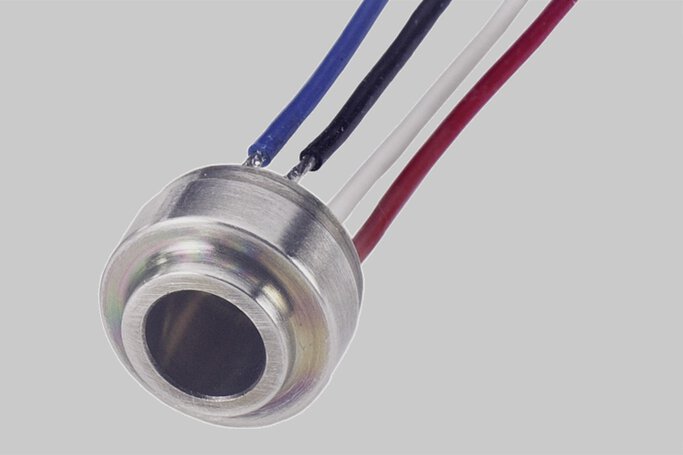
Housing of a thin-film pressure sensor
Do pressure transmitters need to be checked regularly?
Pressure transmitters have a good long-term behavior. Depending on the manufacturer and industrial sensor design, the specified long-term behavior is usually 0.1 - 0.5 % of the measuring span/year. Nevertheless, regular inspection is recommended for optimum functionality in industrial applications. During this so-called DAkkS calibration or ISO calibration, the pressure sensor is subjected to a reference pressure and the deviations are determined. The deviation is compensated by an adjustment (either on the pressure sensor or on the evaluation unit) if it is acceptable. Reliable processes are achieved through calibration.
Which pressure sensors are commonly used in process technology?
In process technology, the following pressure sensors are used in the majority of applications:
- Ceramic thick-film pressure sensors (can be used from 1.6 bar)
- Piezoresistive silicon sensors (measurement also below 1.6 bar)
- ${title}${badge}
